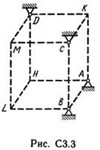Solution C3-32 (Figure C3.3 condition 2 SM Targ 1989)
Content: s3-32.doc.RAR (22.91 KB)
Uploaded: 24.04.2016
Positive responses: 0
Negative responses: 0
Sold: 0
Refunds: 0
Seller: Михаил_Перович
information about the seller and its items
Loyalty discount! If the total amount of your purchases from the seller more than:
| $1 | the discount is | 1% |
| $5 | the discount is | 2% |
| $10 | the discount is | 3% |
| $20 | the discount is | 5% |
| $50 | the discount is | 7% |
| $100 | the discount is | 10% |
| $200 | the discount is | 15% |
$0.55
Solution C3-32 (Figure C3.3 condition 2 SM Targ 1989)
Six weightless rods are connected by their ends to each other in two knots and fixed at their other ends (also hinged) to the fixed supports A, B, C, D (Figure C3.0-C3.9, Table C3). Rods and knots (nodes are located at the vertices of H, K, L or M rectangular parallelepiped) in the figures are not shown and should be depicted as solving the problem according to the table. In the node, which is indicated first in each column of the table, a force P = 200 N is applied; The force P forms, with positive directions of the coordinate axes x, y, z, the angles equal to respectively α1 = 45 °, β1 = 60 °, γ1 = 60 °, and the force Q - the angles α2 = 60 °, β2 = 45 °, γ2 = 60 °; The directions of the x, y, and z axes for all the figures are shown in Fig. CZ.0. The faces of the parallelepiped parallel to the xy plane are squares. The diagonals of the other lateral faces form an angle φ = 60 ° with the xy plane, and the diagonal of the parallelepiped forms an angle θ = 51 ° with this plane. Determine the forces in the rods. In Fig. C3.10 shows, as an example, how the S3 drawing should look. 1, if by the conditions of the problem the nodes are at the points L and M, and the rods are LM, LA, LB; MA, MS, MD. The angles φ and θ are also shown there.
Six weightless rods are connected by their ends to each other in two knots and fixed at their other ends (also hinged) to the fixed supports A, B, C, D (Figure C3.0-C3.9, Table C3). Rods and knots (nodes are located at the vertices of H, K, L or M rectangular parallelepiped) in the figures are not shown and should be depicted as solving the problem according to the table. In the node, which is indicated first in each column of the table, a force P = 200 N is applied; The force P forms, with positive directions of the coordinate axes x, y, z, the angles equal to respectively α1 = 45 °, β1 = 60 °, γ1 = 60 °, and the force Q - the angles α2 = 60 °, β2 = 45 °, γ2 = 60 °; The directions of the x, y, and z axes for all the figures are shown in Fig. CZ.0. The faces of the parallelepiped parallel to the xy plane are squares. The diagonals of the other lateral faces form an angle φ = 60 ° with the xy plane, and the diagonal of the parallelepiped forms an angle θ = 51 ° with this plane. Determine the forces in the rods. In Fig. C3.10 shows, as an example, how the S3 drawing should look. 1, if by the conditions of the problem the nodes are at the points L and M, and the rods are LM, LA, LB; MA, MS, MD. The angles φ and θ are also shown there.
No feedback yet

